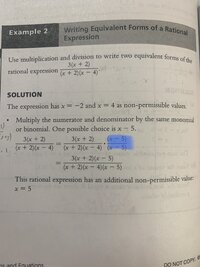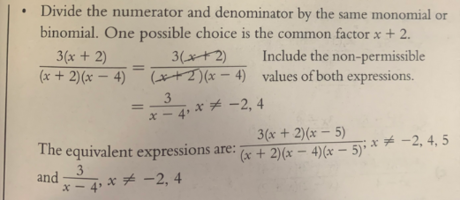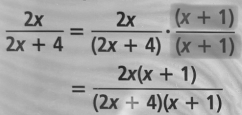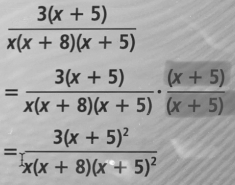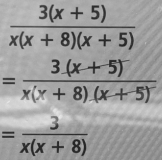You are using an out of date browser. It may not display this or other websites correctly.
You should upgrade or use an alternative browser.
You should upgrade or use an alternative browser.
how do I know? (equivalent forms of rational expression)
- Thread starter senakuny
- Start date
Dr.Peterson
Elite Member
- Joined
- Nov 12, 2017
- Messages
- 16,087
I don't think this makes any sense, as written. The "problem" says,View attachment 35403
The textbook mentions that one of the possible choice is x-5. how do I know that one of the possible choice is x-5?
But their "answer" is not equivalent! What they apparently meant to say is, write an expression that is equivalent to this, except for some value(s) of x where the new expression is not defined. That is what they actually did, as they say:
Given my version of what they are asking, they could multiply the numerator and denominator by anything. So (x-5) is one of infinitely many possible choices. They just chose one at random.
Since they asked for two forms, I imagine they must give at least one other "answer"; and perhaps that is one that is actually equivalent, in which case, perhaps the problem is not as bad as it seems.
Please show us the entire answer, so we can see if they correct this answer and explain what they are doing.
I don't think this makes any sense, as written. The "problem" says,
But their "answer" is not equivalent! What they apparently meant to say is, write an expression that is equivalent to this, except for some value(s) of x where the new expression is not defined. That is what they actually did, as they say:
Given my version of what they are asking, they could multiply the numerator and denominator by anything. So (x-5) is one of infinitely many possible choices. They just chose one at random.
Since they asked for two forms, I imagine they must give at least one other "answer"; and perhaps that is one that is actually equivalent, in which case, perhaps the problem is not as bad as it seems.
Please show us the entire answer, so we can see if they correct this answer and explain what they are doing.
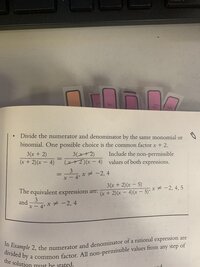
this is an another example with division.
Dr.Peterson
Elite Member
- Joined
- Nov 12, 2017
- Messages
- 16,087
Okay, it's what I initially thought: When they say "equivalent", they mean only that the values are the same except a few places where one might be defined and the other not.View attachment 35408
this is an another example with division.
Also, the first example is not something you'd be asked to do on a test, or need to do to solve a problem; they are merely demonstrating how two rational functions can be [almost} equivalent. The second example is: It's how you simplify an expression to get rid of "holes" where it is undefined. In this case, there is a reason to choose (x+2): It's a common factor that can be removed.
Okay, it's what I initially thought: When they say "equivalent", they mean only that the values are the same except a few places where one might be defined and the other not.
Also, the first example is not something you'd be asked to do on a test, or need to do to solve a problem; they are merely demonstrating how two rational functions can be [almost} equivalent. The second example is: It's how you simplify an expression to get rid of "holes" where it is undefined. In this case, there is a reason to choose (x+2): It's a common factor that can be removed.
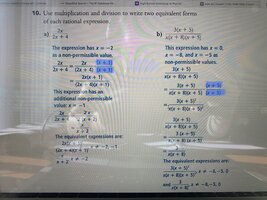
there is this question that is pretty similar to the example that I just showed. In these two problems in the answer key, they decided to use (x+1) and (x+5) for other question. Is there any specific reason why they chose this number? Or is the reason nothing really significant?
MaxMath
Junior Member
- Joined
- Mar 22, 2023
- Messages
- 90
I think so. This is where language sometimes becomes tricky and extra clarification and care would really help.Or is the reason nothing really significant?
Dr.Peterson
Elite Member
- Joined
- Nov 12, 2017
- Messages
- 16,087
They're mostly just asking you to duplicate the work they did in the example you showed before, and the issues are identical, except for some oddities in what they actually did.View attachment 35454
there is this question that is pretty similar to the example that I just showed. In these two problems in the answer key, they decided to use (x+1) and (x+5) for other question. Is there any specific reason why they chose this number? Or is the reason nothing really significant?
What I missed at first is that they say to "use multiplication and division", and for each part they did both, equivalent to the two answers in your example. I had to look closely to realize that they were doing two things to each expression.
For (a), they first multiplied by (x+1); they could have used absolutely any factor; multiplying top and bottom by any (x-c) will result in an expression equal to the original except at x=c. (I myself might have chosen to use (x+2), which would not change the set of values for which the expression is defined! Do you see why?)
For their second answer in (a), they observed that the top and bottom both have a factor of 2, so they removed it by dividing both by 2:
This was not arbitrary; it had to be a factor that was already there. This is called simplifying, and is very useful. The multiplication is useful primarily when you want to change the denominator to match another expression; then the factor you use is determined by your goal. By not explaining that, they are making this look too complicated!
For (b), they again gave two answers, one by multiplying and another by dividing.
For the first they multiplied top and bottom by the arbitrarily chosen (x+5) resulting in square factors because that factor was already there:
This is like what I wanted to do for part (a), duplicating factors that are already there.
For the second, there was a common factor, (x+5), which they wanted to remove. So they divided top and bottom by (x+5), also called cancelling:
I'm not at all happy with their wording, or with their explanations. But they are doing what they said to do, when you understand it.
By the way, your computer should be able to take screen shots, so you wouldn't have to take pictures of the screen yourself. That has much better results.
I will make sure to screenshot next time haha, and thank you for the clarification! although the text was confusing and messy, your reasoning has helped my understanding!They're mostly just asking you to duplicate the work they did in the example you showed before, and the issues are identical, except for some oddities in what they actually did.
What I missed at first is that they say to "use multiplication and division", and for each part they did both, equivalent to the two answers in your example. I had to look closely to realize that they were doing two things to each expression.
For (a), they first multiplied by (x+1); they could have used absolutely any factor; multiplying top and bottom by any (x-c) will result in an expression equal to the original except at x=c. (I myself might have chosen to use (x+2), which would not change the set of values for which the expression is defined! Do you see why?)
For their second answer in (a), they observed that the top and bottom both have a factor of 2, so they removed it by dividing both by 2:
This was not arbitrary; it had to be a factor that was already there. This is called simplifying, and is very useful. The multiplication is useful primarily when you want to change the denominator to match another expression; then the factor you use is determined by your goal. By not explaining that, they are making this look too complicated!
For (b), they again gave two answers, one by multiplying and another by dividing.
For the first they multiplied top and bottom by the arbitrarily chosen (x+5) resulting in square factors because that factor was already there:
This is like what I wanted to do for part (a), duplicating factors that are already there.
For the second, there was a common factor, (x+5), which they wanted to remove. So they divided top and bottom by (x+5), also called cancelling:
I'm not at all happy with their wording, or with their explanations. But they are doing what they said to do, when you understand it.
By the way, your computer should be able to take screen shots, so you wouldn't have to take pictures of the screen yourself. That has much better results.

